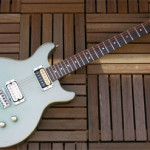Difference Between Overdrive and Distortion
 Overdrive vs Distortion
Overdrive vs Distortion
Both professional and aspiring guitarists should learn about the difference between overdrive and distortion. In order for you to play your instrument better, it is a must to familiarize yourself with these basic terms. So, when do you need to create a distortion or an overdrive effect when playing your instrument?
First, here’s a quick definition of the two terms. Just like gain, overdrive and distortion are terms used when a guitarist creates a sound effect while playing his instrument. It can either add or distract from the overall tone that your guitar makes, which is why it is a must for you to practice, and determine the difference between the two.
It may be a bit difficult to describe what the actual sound of your guitar will be like, but there’s a general description that can be used. Overdrive produces a smooth and warm, but a bit distorted sound. If you listen to how a tube amp is cranked up, that is a similar sound that overdrive produces.
Distortion, on the other hand, has a variety of effects on the sound of a guitar. It can produce a fuzz-like effect, or a full-on sound of a death metal band. There are as many varieties of distortion as there are guitar players ‘“ because it depends on a player’s individual style.
There are two types of distortion produced: Digital and analog. With digital distortion, the sound produced has a raspy noise to it, while analog distortion is a classic tone that you can hear played by rock bands.
Moreover, distortion is the sound produced by heavy metal, classic rock and heavy rock bands. With overdrive, the sound is generally more bluesy. Pedals are the equipment used on a guitar to create these effects ‘“ and choosing the right one is all a matter of a guitar player going with what feels right with a song.
Summary:
1. Overdrive is a guitar effect created with pedals, while distortion is also a sound effect created with pedals attached to a guitar.
2. Overdrive is a smooth and warm, but distorted sound, while distortion is a range of tunes which can be unnoticeable, or as loud as the sound from a heavy metal band.
3. Overdrive has a bluesy sound to it, while distortion lets you go back to your true rock roots.
- Difference Between NP and PA - April 25, 2010
- Difference Between Goth and Vampire - April 4, 2010
- Difference Between Our and Are - April 4, 2010
Search DifferenceBetween.net :
 Email This Post
: If you like this article or our site. Please spread the word. Share it with your friends/family.
Email This Post
: If you like this article or our site. Please spread the word. Share it with your friends/family.


My Ibanez TS9DX is an overdrive pedal while my ProCo Rat is a distortion. They both have about the same level of gain on tap but are clearly different sounding. When you use an overdrive pedal (even with the gain maxed-out), much of the clean characteristics of your guitar are still audible but with added breakup and sustain around it. With distortion, the signal clips in a way to shape the overall guitar sound into something aggressive which people associate with Metal or Classic Rock players. Gives it more teeth I guess?
I wouldn’t say distortion is necessarily digital like others have said because both types or gain were available in pedals long before digital effects and both sounded different. But I understand why people say one is bluesy and the other is edgy. There’s a clear difference between the guitar tone of Hendrix and Stevie Ray Vaughn vs. something like Metallica or 70’s Aerosmith. At least that’s how my ears distinguish between the two. I use both of my pedals individually or together for different sounds I’m trying to achieve.
This is how I look at it, and it may not be literally accurate. As it applies to guitars, distortion is a quality of sound that occurs when you ‘overdrive’ the tubes in a tube amplifier. You could say that an ‘overdriven sound’ is nothing more than a clean signal that is driven so hard that it naturally distorts.
Most guitarists, however, are asking the question as it relates to floor pedals, or buttons on the front of their amplifier.
Pedals generally fall into 3 categories: Overdrive, distortion, and fuzz and are often referred to collectively as distortion pedals because that’s what they are. They’re pedals that are designed to create distorted guitar tones.
“Overdrive pedals” create the type of distortion you’d get from an overdriven vintage-style tube amp. Though they are also often used to boost an already overdriven amp as well.
“Distortion pedals” create a sort of greatly overdriven sound that is generally beyond the capabilities of most vintage tube amps, although many modern amps have ample amounts of gain and can get well into high gain distortion territory.
“Fuzz pedals” are basically gain pedals that distort your tone so much as to almost completely destroy it and tend to sound somewhat muddy, or muffled with a lot of bass response with a lot of overtones.